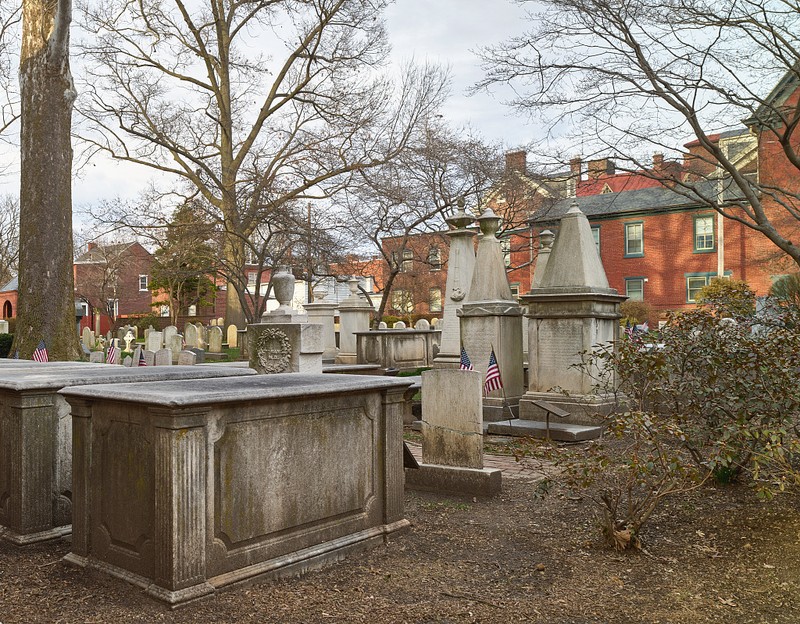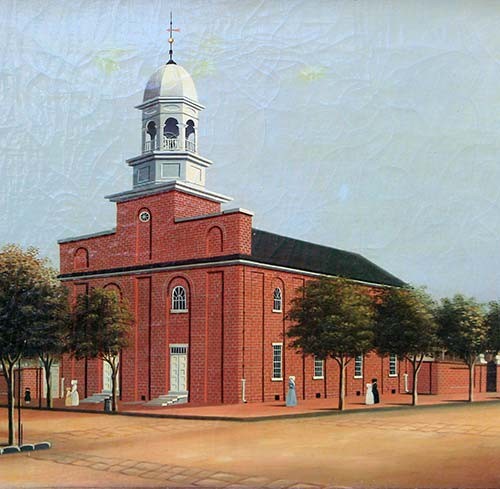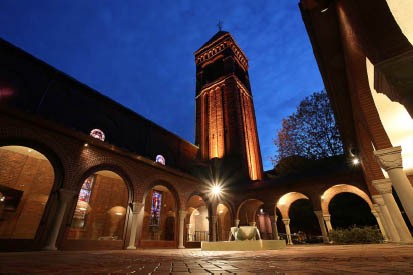St. James Episcopal Church
Introduction
Text-to-speech Audio
Images
St. James Episcopal Church.

Cemetery at St. James Episcopal Church.

Saint James Church, E.H. Hammond, 1844.

St. James Episcopal Church.

The inside of St. James Episcopal Church.

Backstory and Context
Text-to-speech Audio
The present St. James Episcopal Church in Lancaster, Pennsylvania was built in 1820, but was originally created in 1744 as an extension of the Church of England in the “New World.” At the time, the Society for the Propagation of the Gospel in Foreign Parts (SPG) was meant to provide Christian ministry to British people overseas. Reverend Richard Locke, a circuit-riding priest from England funded by the SPG, was given 20 pounds by King George II to assist in financing his transportation to the New World as a missionary. Locke gathered members of the Church of England together with a small group of influential colonists, such as signer of the Declaration of Independence George Ross, and established a congregation on land donated by James Hamilton, who was known as the “Father of Lancaster.” The congregation of the Church of England later became known as St. James Episcopal Church.
Difficulty surrounded funding the new church due to German and Swiss settlers outnumbering British settlers. Initially, the congregation met in the first county courthouse, which at the time was located in Penn Square. Soon, wealthy members of the congregation helped fund a stone church on the corner of Duke and Orange Streets, which was constructed in 1753. By 1761, two lotteries had raised money to pay for a steeple. Because there were no bishops in the colonies prior to the American Revolution, the St. James clergy were SPG missionaries who had to travel to Britain to be ordained, and each priest served in multiple churches in the state.
After the singing of the Declaration of Independence in 1776, the church was forced to close due to conflicts between a rector who was loyal to the Church of England and a congregation of prominent patriots. The church remained closed throughout the Revolutionary War, resuming services in 1783. After the war, the church wanted to become a separate American branch of the Anglican Communion (English Church). Though it still had a relationship with its “mother” church in England, St. James was self-governing by 1789, with its own bishops and Book of Common Prayer.
Although African American members of the congregation had always worshipped at St. James, seating in the church was segregated. Around 1820, members of the Black community helped establish a separate church, which was known as the St. James African Church until the late 1840s, before adopting the name Bethel African Methodist Episcopal Church. That same year, a new St. James building was constructed using the old steeple. Since the church’s founding, members were also required to pay a pew rent to worship there. Although the first “free” church in the Diocese of Pennsylvania was founded in 1853, it was not until 1929 that services at St. James became free as well.
Many clergy and parishioners from St. James Episcopal Church have had prominent roles in religion and education during its time. 11 former rectors and members of the parish have become bishops, and Bishop Charles Inglis became the first colonial bishop of the Church of England as bishop of Nova Scotia in 1787. In 1977, Elizabeth W. Myers was the first women to be ordained as a priest in the Diocese of Central Pennsylvania. Additionally, William Augustus Muhlenberg was credited for Lancaster establishing the second public school district in the state, as well as being the founder of the church school movement that created many Episcopal boarding schools. The movement for state teacher training colleges was also headed by a parishioner, Dr. Thomas Burrowes. In the 19th century, the church established a home for the elderly and an orphanage, and also had a breakfast program that fed the hungry for over 30 years. The church now remains on the corner of Duke and Orange Streets, and is home to a cemetery with over 200 years of history.
Sources
- Saint James Episcopal Church. October 2007, Lancaster History. Accessed November 6th 2020. https://www.lancasterhistory.org/finding-aids/saint-james-episcopal-church/.
- History of Saint James, Saint James Episcopal Church. Accessed November 6th 2020. https://www.saintjameslancaster.org/history/.
- The First Century, Saint James Episcopal Church. Accessed November 6th 2020. https://www.saintjameslancaster.org/history/treasured-journey-exhibit/the-first-century/.
- ST. JAMES’ EPISCOPAL CHURCH, Society of Architectural Historians. Accessed November 6th 2020. https://sah-archipedia.org/buildings/PA-02-LA18.
- St. James Episcopal Church, LYHR. July 25th 2020. Accessed November 6th 2020. https://www.lyhr.org/st-james-episcopal-church/.
- Highsmith, Carol M.. Cemetery of the St. James Episcopal Church in Lancaster, Pennsylvania, Library of Congress. March 28th 2019. Accessed November 6th 2020. https://www.loc.gov/item/2019689060/.
https://www.lyhr.org/st-james-episcopal-church/
https://www.loc.gov/item/2019689060/
https://www.saintjameslancaster.org/history/treasured-journey-exhibit/the-first-century/
https://sacredplaces.org/a-tale-of-two-churches-lancaster-churches-address-spiritual-social-and-environmental-needs/
https://www.google.com/url?sa=i&url=https%3A%2F%2Fwww.pinterest.com%2Fpin%2F96194142016800301%2F&psig=AOvVaw3TTpHz5sF6zBZUE-BO0NDk&ust=1604732805738000&source=images&cd=vfe&ved=0CAMQjB1qFwoTCLD3uumt7ewCFQAAAAAdAAAAABAK
